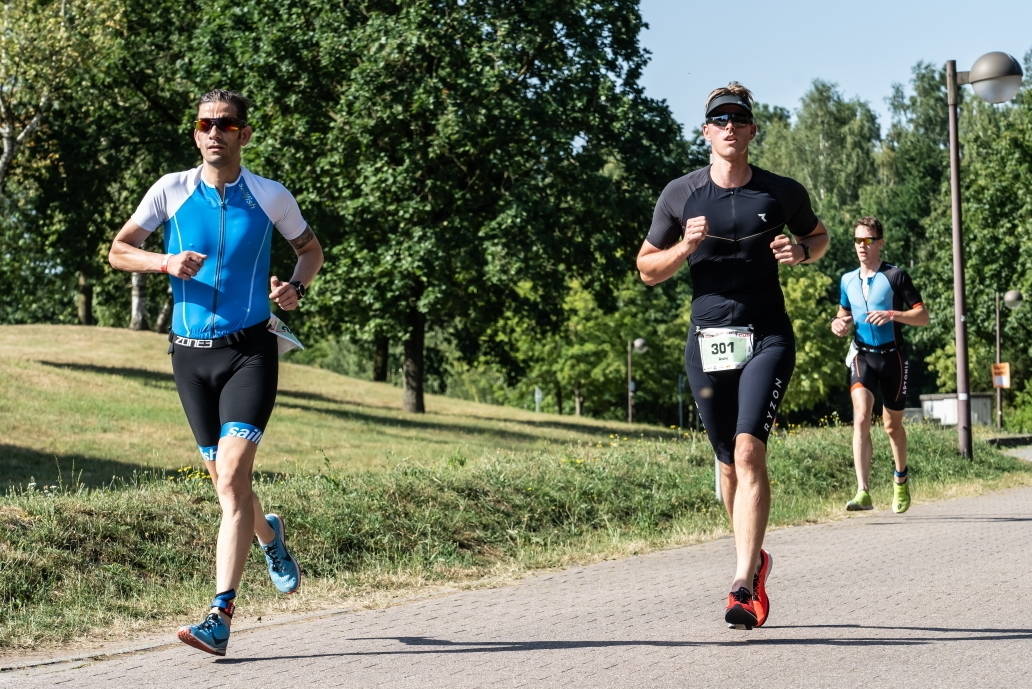Nachdem ihr in den letzten beiden Artikeln erfahren habt, wie ihr euch für Schwimmen und Radfahren möglichst effektiv vorbereitet, geht es jetzt zur letzten Disziplin - dem Laufen. Die Distanz der Laufstrecke beim Volkstriathlon (5km) klingt erstmal nach nicht so viel. Vergleichbar mit der normalen Joggingrunde ist die letzte Triathlon Disziplin trotzdem nicht.
Es ist sowohl für Körper als auch Geist eine ganz andere Belastung nach den ersten beiden Disziplinen noch laufen zu müssen. Die Muskulatur ist bereits ermüdet und die Umstellung der Bewegung kann Schwierigkeiten bereiten. Vertraut also nicht nur auf eure Ausdauer, da nach der Vorbelastung ein ökonomischer Laufstil und eine stabile Technik unter Ermüdungs-Bedingungen beibehalten und dafür zuerst erlernt werden muss. Wie ihr das schafft, erfahrt ihr in folgendem Artikel.
Technikschulung
Um deinen Körper und Laufstil auf die veränderte Belastung möglichst umfangreich vorzubereiten, ist es sinnvoll und wichtig sogenannte Lauf-ABCs ins Training zu integrieren. Diese bestehen aus Einheiten für Fußgelenk, Hüftgelenk, Kniegelenk und Stabilität. Auch Sprünge und koordinative Übungen sind enthalten und alles sollte mit großer Präzision und Konzentration über kurze Streckenabschnitte verteilt durchgeführt werden. Das Ziel des Lauf-ABCs ist die Sensibilisierung auf verschiedene Teilbewegungen des Laufens um die Technik dadurch zu ökonomisieren. Bindest du diese Übungen einmal pro Woche in dein Lauftraining ein, kann das bei Neulingen schnell zu großen Fortschritten führen.
Steigerung der Streckenlänge
Falls dir die 5 Kilometer bereits an sich Probleme bereiten, solltest du dich als erstes darauf konzentrieren. Dazu kannst du konstant die Distanz deiner Trainingsabschnitte erhöhen, bis du die Zielentfernung relativ problemlos zurücklegen kannst. Falls es für dich anfangs noch nicht möglich ist durchgehend zu joggen, kannst du dich alternativ mit zügigem Gehen oder langsamen Laufen erholen und dadurch die Dauer der Trainingsbelastung etwas erhöhen. Versuche die gegangene Zeit dann immer weiter zu reduzieren und nimm dir als Ziel für deinen ersten Triathlon, 1 Stunde in moderatem Tempo laufen zu können.
Geschwindigkeit erhöhen
Um die Laufstrecke möglichst schnell zu absolvieren, reicht es nicht, wenn du im Training immer nur monotonen Dauerlauf betreibst. Dein Training sollte aus Grundlageneinheiten mit mittlerem Tempo (<75% der Hfmax) und Intervalleinheiten mit erhöhtem Tempo bestehen. Durch den Wechsel zwischen Erholungs- und Belastungsphasen beim Intervalltraining kommt es am effizientesten zu einer Steigerung der Laufgeschwindigkeit. Während der Belastungsphase sollte dein Tempo deutlich über deinem Dauerlauf- und sogar etwas über deinem Ziel-Wettkampf-Tempos liegen. In der Erholungsphase ist es in Ordnung nur locker zu traben oder zu gehen.
Wo trainieren?
Profis trainieren ihre Geschwindigkeit meist auf der Bahn um ihr Tempo möglichst exakt kontrollieren zu können. Falls dir das als Einsteiger zu monoton ist, kannst du auch deine normale Laufrunde nutzen. Du solltest nur darauf achten, dass diese nicht zu viele Höhenmeter besitzt. Falls du Probleme mit deiner Motivation hast, kann auch das Training in der Gruppe helfen die richtige Geschwindigkeit zu halten, da man sich gegenseitig unterstützen und antreiben kann.
Richtiges Training
Bevor du mit deinem Intervallprogramm richtig loslegst, solltest du dich zuerst gut aufwärmen. Integriere hier auch ruhig wieder ein paar Übungen des Lauf-ABCs oder absolviere ein paar Steigerungsläufe. Hast du dein Training erfolgreich absolviert, dann spring nicht sofort ins Auto oder unter die Dusche, sondern laufe dich noch locker etwas aus.
Entdecke die riesige Trisuit-Kollektion
Vom Basic Einteiler bis hin zum High-End Aerosuit
Beispielprogramm - Intervalleinheit
- Woche: 2 x 400 m oder 2 x 2 min, 1 min locker traben
- Woche: 4 x 400 m oder 4 x 2 min, 1 min locker traben
- Woche: 6 x 400 m oder 6 x 2 min, 1 min locker traben
- Woche: 3 x 1000 m oder 3 x 5 min, 2 min locker traben
- Woche: 4 x 1000 m oder 4 x 5 min, 2 min locker traben
- Woche: 5 x 1000 m oder 5 x 5 min, 2 min locker traben
Triathlon-Spezifisch Laufen
Wie bereits gesagt, kommt es nicht nur auf deine Ausdauer an, sondern eben auch auf deine Performance unter Ermüdungsbedingungen. Um dies in der Vorbereitung zu üben, eignet sich sogenanntes Koppeltraining, bei dem du die Triathlon-Disziplinen eben auch im Training aneinander “koppelst”. Du kannst beispielsweise einfach vor einer 30min Lauf-Einheit noch eine Stunde auf dem Rad verbringen. Dadurch lernt dein Körper die Belastungswechsel kennen und du kannst üben auch unter Ermüdung effektiv zu laufen. Das Tempo und die Länge deines Koppeltrainings kannst du hierbei gerne variieren. Und um deine Geschwindigkeit zu verbessern, baue am Ende des Dauerlaufs am besten noch ein paar Steigerungsläufe ein.
Dosis des Koppeltrainings
Da du deinem Körper hier starker Belastung aussetzt, solltest du die Koppeleinheiten als Einsteiger recht dosiert einsetzen. Besser du kümmerst dich zuerst darum, deine Technik, Ausdauer und Geschwindigkeit zu trainieren und kümmerst dich dann an die Gewöhnung der Bewegungs- und Belastungsunterschiede beim Koppeltraining.
Wenn du all das in deinem Lauftraining berücksichtigst, sollten die letzten Kilometer deines ersten Volkstriathlons kein Problem mehr darstellen!
Die gesamte Serie: Fit für den Volkstriathlon
#3 Laufen: die letzten Kilometer




















